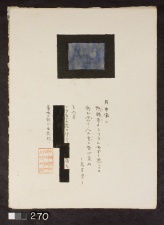Difference between revisions of "Tsuki kusa (Dayflower) - center (270 C)"
Jump to navigation
Jump to search
(username removed) |
m (MDerrick moved page Tsuki kusa - center (270 C) to Tsuki kusa (Dayflower) - center (270 C) without leaving a redirect) |
||
| (3 intermediate revisions by 2 users not shown) | |||
| Line 5: | Line 5: | ||
| 270 | | 270 | ||
|- | |- | ||
| − | ! scope="row"| | + | ! scope="row"|Uemura number / title |
| − | | | + | | ; "Haze-some 25" |
|- | |- | ||
! scope="row"|Folder location | ! scope="row"|Folder location | ||
| Line 22: | Line 22: | ||
! scope="row"|Dyestuff (Japanese common name) | ! scope="row"|Dyestuff (Japanese common name) | ||
| つき草 : Tsuki kusa | | つき草 : Tsuki kusa | ||
| + | |- | ||
| + | ! scope="row"|Dyestuff (English common name) | ||
| + | | Dayflower | ||
|- | |- | ||
! scope="row"|Dyestuff (botanical name) | ! scope="row"|Dyestuff (botanical name) | ||
| Line 41: | Line 44: | ||
| - | | - | ||
|- | |- | ||
| − | ! scope="row"| | + | ! scope="row"|Uemura's notes |
| − | | The yellow dots on the fabric are pollen of the flower. The plant was read in a Japanese classic poem in the | + | | The yellow dots on the fabric are pollen of the flower. The plant was read in a Japanese classic poem in the Manysh () ,from the 7th -8th century AD: |
|- | |- | ||
| − | ! scope="row"| | + | ! scope="row"|Uemura's date |
| Kyoto Murasakino | | Kyoto Murasakino | ||
|} | |} | ||
| − | [[Category: | + | [[Category:Uemura dye archive]] |
Latest revision as of 08:52, 24 June 2020
| Museum number | 270 |
|---|---|
| Uemura number / title | ; "Haze-some 25" |
| Folder location | 4th shelf |
| Sample location | center (270 C) |
| Fiber type | silk |
| Color | light blue + yellow dots |
| Dyestuff (Japanese common name) | つき草 : Tsuki kusa |
| Dyestuff (English common name) | Dayflower |
| Dyestuff (botanical name) | Commelina communis L. |
| Plant part | flower juice and pollen / fresh |
| Dyestuff extraction | dyed with flower juice |
| Auxiliary agent in dye bath | - |
| Mordant | - |
| Other auxiliary agent | - |
| Uemura's notes | The yellow dots on the fabric are pollen of the flower. The plant was read in a Japanese classic poem in the Manysh () ,from the 7th -8th century AD: |
| Uemura's date | Kyoto Murasakino |
